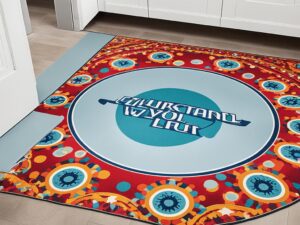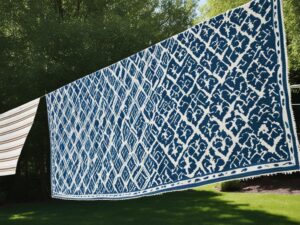Are you tired of tripping over the excess length of your rug or struggling to find the perfect fit for your space? Don’t worry, you don’t have to settle for a rug that’s too long or awkwardly folded. With some simple rug trimming techniques, you can easily shorten your rug to achieve the perfect length and proportions for any room. In this guide, we will walk you through the rug alteration methods, tips, and hacks to trim a rug at home.
Before diving into the process of DIY rug shortening, it’s important to understand what makes a good trimmable rug. Not all rugs are suitable for resizing, as some may have patterns or designs that could be compromised during the cutting process. Additionally, the material of the rug should be considered, as certain fabrics may unravel or fray when trimmed.
While professional rug resizing services exist, they can be costly. By learning how to cut a rug to size yourself, you can save money and achieve a customized fit. Keep reading to discover the necessary supplies, step-by-step instructions, and essential rug tailoring tips to successfully resize your rug at home.
Key Takeaways:
- Trimming a rug at home allows you to achieve the perfect length and proportions for your space.
- Not all rugs are suitable for resizing due to their patterns or materials.
- DIY rug shortening can be a cost-effective alternative to professional resizing.
- Follow step-by-step instructions and use the right tools to ensure a successful rug trimming process.
- Take proper safety precautions, such as using sharp tools with caution and wearing protective gloves.
The Benefits of Rug Resizing
Resizing a rug offers a range of benefits that can significantly enhance the overall look and functionality of your space. Whether you want to customize the size to fit a specific room or repurpose an existing rug, resizing provides a practical solution. Let’s explore the key advantages of rug resizing:
Improving Room Proportions
One of the primary benefits of resizing a rug is the ability to improve room proportions. A rug that is too large or too small can disrupt the visual balance of a space. By resizing the rug to better fit the dimensions of the room, you can achieve a harmonious aesthetic that complements the overall design.
Repurposing Rugs
Resizing a rug also presents an opportunity to repurpose an existing piece. Perhaps you have a beautiful rug that doesn’t quite fit the intended area. Instead of letting it go to waste, resizing allows you to give the rug a new lease on life by adapting it to a different room or space.
Avoiding Trip Hazards
Oversized rugs that extend beyond the furniture can pose a trip hazard, especially in high-traffic areas. By resizing the rug to the optimal size, you can eliminate any folds or excess material that may cause accidents. This is particularly important in homes with children or elderly residents.
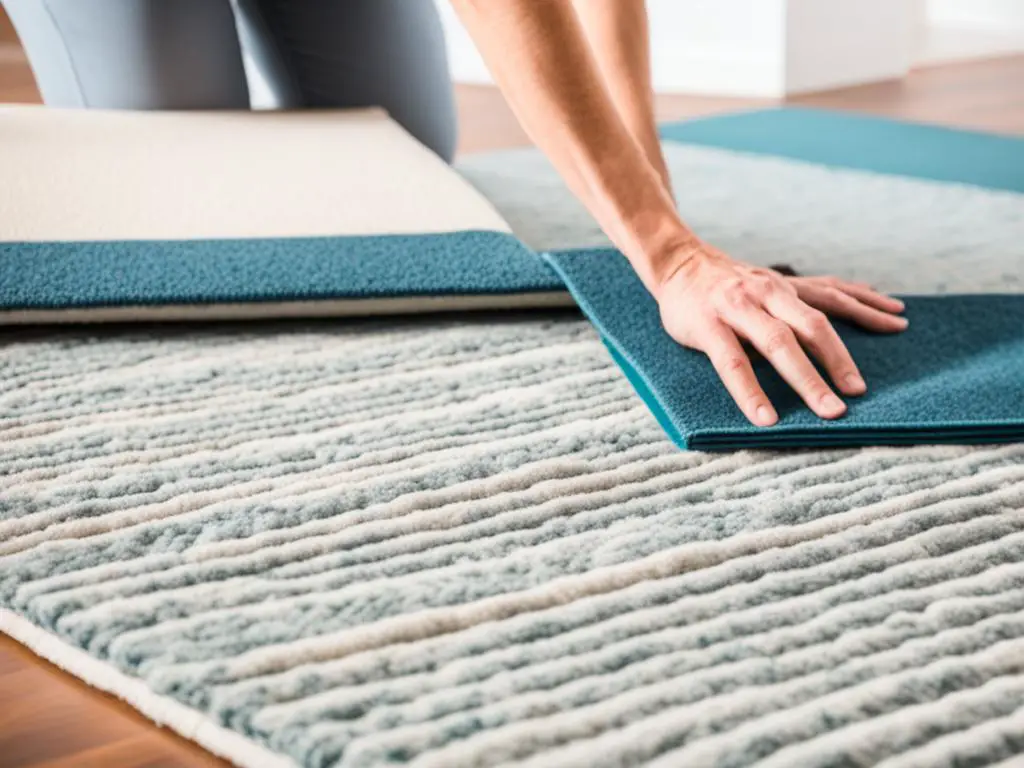
Resizing a rug provides an opportunity to not only improve the aesthetics but also enhance the practicality of your space. Whether you are looking to customize the size, repurpose an existing rug, or avoid trip hazards, the benefits of rug resizing are undeniable.
| Benefits of Rug Resizing |
|---|
| Improves room proportions |
| Allows repurposing of rugs |
| Eliminates trip hazards |
Professional Rug Resizing vs. DIY Methods
When it comes to resizing a rug, you may be wondering whether to hire a professional or tackle the task yourself. Both approaches have their advantages and disadvantages. Let’s explore the pros and cons of professional rug resizing and DIY methods to help you make an informed decision.
Professional Rug Resizing
Choosing professional rug resizing offers several benefits. First and foremost, professionals possess the necessary expertise and craftsmanship to handle even intricate rug patterns. They are trained to preserve the integrity of the rug’s design, ensuring that no detail is lost during the resizing process.
“I firmly believe in the importance of professional craftsmanship when it comes to resizing rugs. It requires skill and precision to maintain the intricate patterns and designs that make a rug unique.” – Rachel Wilson, Rug Resizing Expert
Another advantage of professional resizing is the assurance of high-quality results. Professional rug resizing companies often use specialized tools and equipment to achieve precise cuts and seamless finishes. Their experience guarantees a flawless outcome.
- Pros of Professional Rug Resizing:
- Expert craftsmanship for preserving intricate patterns
- Specialized tools and equipment for precise cuts
- Assurance of high-quality results
- Saves time and effort
- Professional advice and recommendations
- Higher cost compared to DIY methods
- Dependent on the availability of professional services
- Potential inconvenience of transporting the rug
DIY Rug Resizing
For those who prefer a hands-on approach, DIY rug resizing can be a rewarding project. It allows you to take control of the process and can be a cost-effective option. However, there are some risks and challenges associated with DIY methods.
One of the main risks is the potential for uneven or imprecise cuts. Without professional expertise, it’s easy to make mistakes that can permanently damage the rug. Additionally, DIY resizing may require investing in tools, such as sharp cutting implements and measuring devices, which can add to the overall cost.
“While DIY rug resizing can be done successfully for small rugs, I always advise caution. Cutting a rug incorrectly can result in irreversible damage, so it’s important to understand the limitations of your skills and equipment.” – Michael Thompson, Rug Enthusiast
- Pros of DIY Rug Resizing:
- Cost-effective compared to hiring professional services
- Opportunity for a hands-on and rewarding project
- Flexibility to work on the rug at your own pace
- Potential for uneven or imprecise cuts
- Risk of permanently damaging the rug
- Investment in tools and equipment
- Requires time, patience, and attention to detail
Ultimately, the decision between professional rug resizing and DIY methods depends on factors such as your budget, the complexity of the rug, and your comfort level with undertaking the task. If the rug holds significant value or features intricate patterns, seeking the expertise of a professional is highly recommended. On the other hand, if you have a small rug or are confident in your DIY skills, you can attempt resizing it yourself.
Please note: It’s always wise to consult with a professional before attempting any rug resizing project, as they can provide advice and recommendations based on the specific rug material and design.
Now that we’ve discussed the pros and cons of professional rug resizing and DIY methods, let’s move on to Section 4, where we will provide step-by-step instructions for DIY rug resizing.
Steps for DIY Rug Resizing
Resizing a rug yourself can be a cost-effective and rewarding project. With the right tools and techniques, you can give your rug a new lease on life. Follow these step-by-step instructions for successful DIY rug resizing:
1. Measuring the Rug for Resizing
The first step in DIY rug resizing is to accurately measure the rug. Lay the rug flat on a clean surface and use a measuring tape to determine the desired size. Measure both the length and width, and make a note of the measurements.
2. Marking the Rug for Cutting
Once you have the measurements, use painter’s tape or masking tape to mark the cutting lines on the rug. Ensure the lines are straight and aligned with the desired dimensions. Take your time to double-check the measurements and markings before proceeding to the next step.
3. Cutting Techniques
When it comes to cutting the rug, choose the appropriate tools based on the thickness and material of the rug. For thinner rugs, a sharp utility knife or carpet knife can be used. Thicker rugs may require a heavy-duty rotary cutter or shears. Always use caution and cut along the marked lines with smooth, steady motions.
4. Finishing and Edging
After cutting the rug to the desired size, it’s important to finish the edges to prevent fraying. One option is to use a serger machine or an overlock stitch on a sewing machine. Alternatively, you can apply a fabric adhesive or fray check along the cut edges. This will secure the fibers and prevent them from unraveling.
5. Prevention of Fraying
Aside from finishing the edges, you can also incorporate preventative measures to minimize fraying. Apply a fabric sealant or fray stop along the cut edges. This will add an extra layer of protection and help maintain the rug’s integrity.
With these DIY rug resizing steps, you can confidently transform your rug to fit your space perfectly. Remember to take your time, use proper cutting techniques, and finish the edges to prevent fraying. Enjoy your resized rug as a beautiful addition to your home!
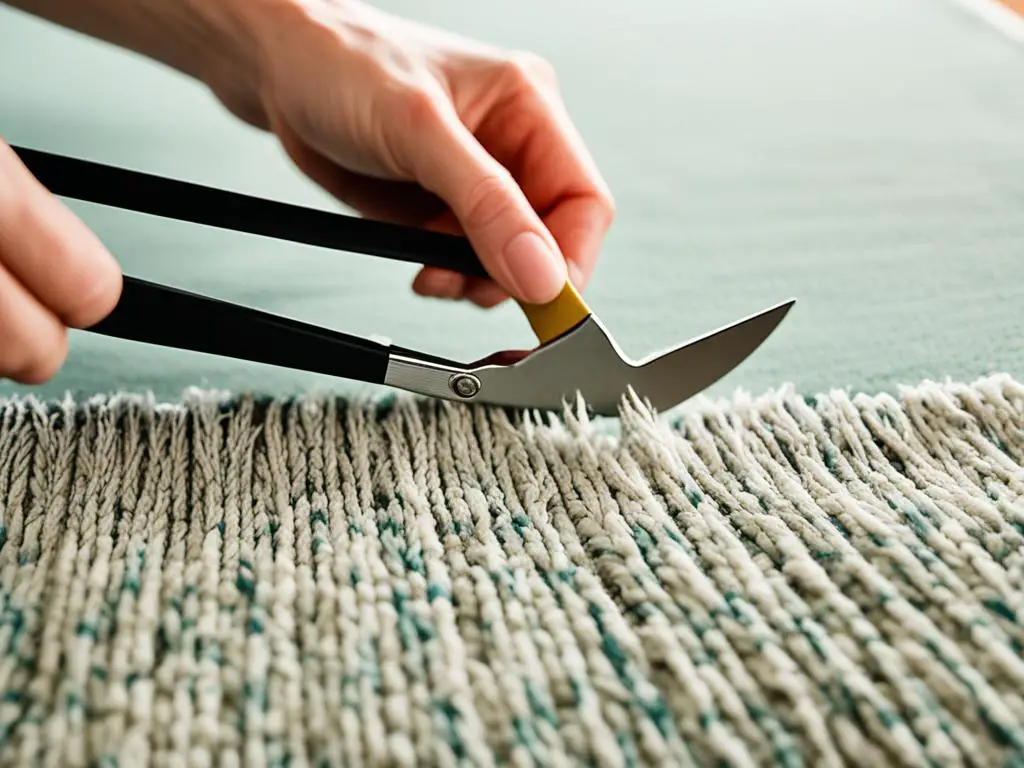
| Step | Description |
|---|---|
| 1 | Measure the rug for resizing |
| 2 | Mark the rug for cutting |
| 3 | Use proper cutting techniques |
| 4 | Finish the edges to prevent fraying |
| 5 | Prevent fraying with fabric sealant or fray stop |
Safety Precautions and Considerations
When it comes to rug resizing, safety should always be a top priority. Taking the necessary precautions can help protect yourself from injuries and ensure the longevity of your carpet. Before you grab your tools and start cutting, here are some essential safety tips to keep in mind:
1. Protecting the Floor
Before you begin resizing your rug, make sure to clear the floor of any obstructions or debris. This will help prevent accidents and ensure a smooth cutting process. Additionally, consider placing a drop cloth or tarp underneath the rug to catch any loose fibers or trimmings.
2. Using Sharp Tools with Caution
Sharp tools, such as utility knives or carpet cutters, are necessary for rug resizing. However, they can also pose a safety risk if not handled with caution. Always use these tools carefully, applying proper pressure and keeping your fingers away from the cutting edge.
3. Wearing Protective Gloves
Protective gloves are essential when working with sharp tools and handling rug materials. They provide an added layer of safety by minimizing the risk of cuts or abrasions. Make sure to wear gloves that fit properly and offer sufficient grip.
4. Avoiding Rushed Cuts
When resizing your rug, take your time and avoid rushed cuts. Trying to speed through the process can lead to uneven or jagged edges, compromising the overall appearance of the rug. Take it slow and steady to achieve clean and precise cuts.
“Remember, safety should always come first when resizing a rug. Take the necessary precautions to protect yourself and ensure a successful outcome.”
By following these safety precautions and considerations, you can minimize the risk of injuries and create a beautifully resized rug. Remember, safety should never be overlooked, especially when working with sharp tools and delicate materials.
| Safety Precautions for Rug Resizing |
|---|
| Protect the floor by clearing obstructions and using drop cloths or tarps. |
| Handle sharp tools with caution to avoid accidents and injuries. |
| Wear protective gloves to protect your hands from cuts and abrasions. |
| Avoid rushed cuts to achieve clean and precise edges. |
Considerations for Different Types of Rugs
When it comes to resizing rugs, it’s important to understand that different types of rugs require different approaches. Whether you have a high-pile shag rug or a delicate antique Oriental rug, here are some considerations to keep in mind:
1. Trimmable Rug Materials
Some rugs are made from materials that are easily trimmable, allowing for straightforward resizing. For example, rugs made from synthetic fibers like nylon or polyester can be easily cut to size without compromising their integrity. These materials often have a uniform structure, making it easier to trim the rug evenly.
2. Suitable Rugs for Resizing
Not all rugs are suitable candidates for resizing. While synthetic fiber rugs are generally easier to resize, natural fiber rugs like wool or silk require more caution. These delicate materials may not hold up well to cutting and may unravel or lose their shape. It is recommended to seek professional assistance when resizing natural fiber rugs to ensure their integrity is preserved.
3. Preserving Rug Integrity
Preserving the integrity of the rug is crucial when resizing. This includes ensuring that the pattern or design of the rug remains intact throughout the resizing process. Careful planning and execution are important to maintain the visual appeal of the rug even after trimming.
4. Preventing Unraveling
One of the main risks when resizing a rug is unraveling. If the edges are not properly secured after trimming, the rug may start to fray or unravel over time. To prevent this, it is essential to finish and edge the trimmed areas carefully. This can be done by binding the edges with rug binding tape or using a serging stitch to secure the edges.
5. Seeking Professional Assistance
While smaller, less intricate rugs can be resized as a DIY project, it is always recommended to seek professional assistance for larger or unique rugs. Professional rug resizing services have the expertise and tools necessary to handle different types of rugs and ensure a high-quality result. This is especially important when dealing with expensive or irreplaceable rugs that require special care.
By considering the type of rug, the materials used, and the level of intricacy, you can make an informed decision on whether to resize the rug yourself or seek professional assistance. Choosing the right approach ensures that the rug retains its integrity and remains a beautiful addition to your home.
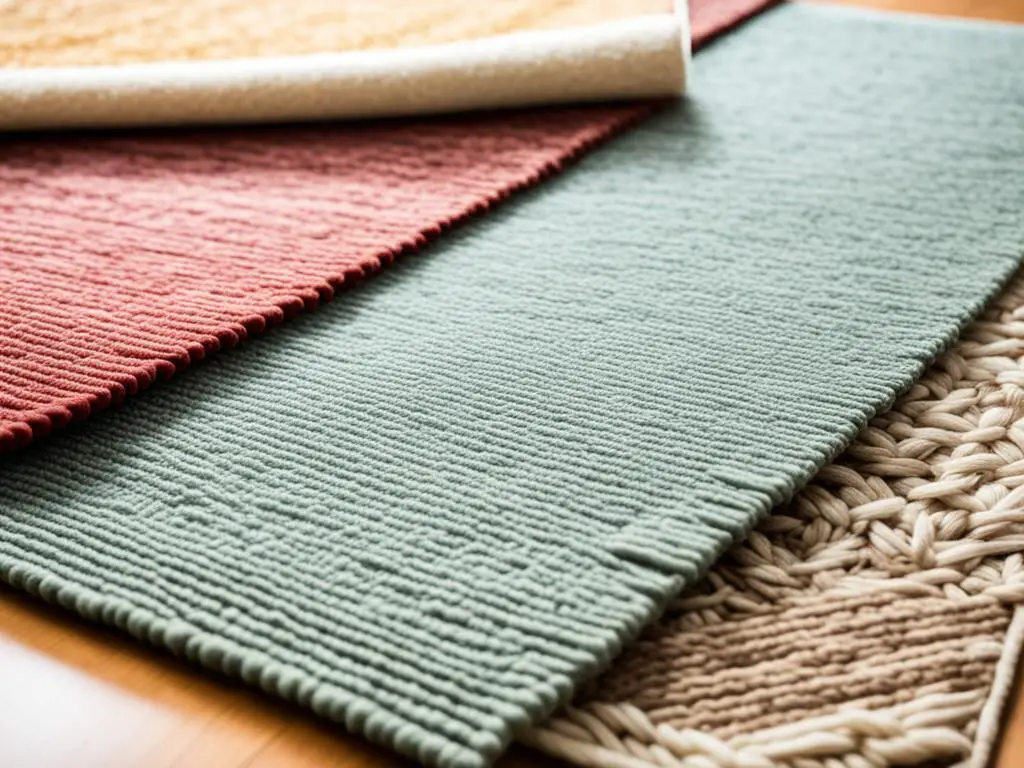
| Type of Rug | Suitability for Resizing |
|---|---|
| Synthetic Fiber (Nylon, Polyester) | Easily trimmable without compromising integrity |
| Natural Fiber (Wool, Silk) | Require caution and recommended professional assistance to preserve integrity |
| High-Pile Shag Rug | May be challenging to trim evenly; professional assistance may be beneficial |
| Antique Oriental Rug | Requires professional expertise to preserve intricate patterns and delicate materials |
Conclusion
In conclusion, resizing a rug offers a range of benefits, including customization options and enhanced room aesthetics. Whether you choose to opt for a do-it-yourself approach or seek professional expertise, it is essential to consider the specific factors discussed throughout this article.
While DIY methods may be suitable for smaller rugs, professional craftsmanship ensures the preservation of intricate patterns and the overall integrity of the rug. By relying on the expertise of skilled professionals, you can achieve a precise and flawless resizing result.
Furthermore, professional rug resizing provides access to a broader range of customization options. Experts can guide you through the process, offering advice on proportions, textures, and materials, allowing you to create a truly personalized rug that perfectly fits your space and style.
When making the decision to resize a rug, consider the size of the rug, its material, and the complexity of its design. For unique or valuable rugs, seeking professional assistance is highly recommended to avoid any potential damage or irreversible alteration. By doing so, you can ensure that your rug is handled with care and precision, resulting in a professionally resized rug that elevates the beauty of your home and meets your specific requirements.


